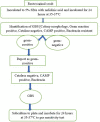Prevalence, Antimicrobial Susceptibility Pattern and Associated Factors of Group B Streptococcus Among Pregnant Women Attending Antenatal Care at Bule Hora University Teaching Hospital, Southern Ethiopia
- PMID: 37435237
- PMCID: PMC10332419
- DOI: 10.2147/IDR.S415414
Prevalence, Antimicrobial Susceptibility Pattern and Associated Factors of Group B Streptococcus Among Pregnant Women Attending Antenatal Care at Bule Hora University Teaching Hospital, Southern Ethiopia
Abstract
Background: In many parts of the world, Group B Streptococcus (GBS) is a major cause of maternal and neonatal illness and mortality. It has a negative impact on neonatal and pregnancy outcomes. A worrisome problem in Ethiopia is the unknown rate of antibiotic resistance and the risk factors connected to GBS infections.
Objective: This study was to determine the prevalence, antibiotic susceptibility pattern, and related variables of Group B Streptococcus among pregnant women receiving prenatal treatment conducted at Bule Hora University Teaching Hospital, Southern Ethiopia, between June 1 and August 30, 2022.
Methods: An institutional-based cross-sectional study was conducted among 213 pregnant women attending antenatal care at Bule Hora University Teaching Hospital. Data on sociodemographic and related factors were gathered using structured questionnaires. The study's participants were selected using the consecutive sampling method. The lower vaginal/rectum area was brushed with a sterile cotton swab to capture the vaginal/rectum swab sample, which was then examined using microbiological techniques. The Kirby-Bauer disc diffusion method was used to assess antibiotic susceptibility in GBS isolates. Logistic regression analysis was performed on the data using SPSS version 26. It was deemed statistically significant when the p-value was 0.05 with a 95% confidence interval (CI).
Results: The overall prevalence of GBS was 16.9% (CI: 0.12-0.23). A history of prematurity of the membrane (AOR: 3.35, 95% CI: 1.19-9.45), a history of stillbirth (AOR: 2.88, 95% CI: 1.07-7.71), and preterm delivery history (AOR: 3.41, 95% CI: 1.31-8.89) (p 0.05) were independent predictors of GBS infection. Cefepime had the highest resistance at 58.3%. Most GBS isolates showed high susceptibility to vancomycin (97.2%) and ampicillin (91.7%). Multidrug resistance was 13.9%.
Conclusion: The prevalence of GBS was considerably high among pregnant women in this study. This finding emphasises the need for routine screening and testing of antimicrobial susceptibility to provide antibiotic prophylaxis and minimise newborn infection and comorbidity.
Keywords: Group B Streptococcus; antimicrobial susceptibility pattern; pregnant women.
© 2023 Husen et al.
Conflict of interest statement
The authors declare no potential conflicts of interest concerning the research, authorship, and publication of this paper.
Figures
Similar articles
-
Trichomonas vaginalis and Associated Factors among Pregnant Women Attending Antenatal Care at Bule Hora University Teaching Hospital, Oromia Region, Southern Ethiopia.J Parasitol Res. 2023 Dec 14;2023:4913058. doi: 10.1155/2023/4913058. eCollection 2023. J Parasitol Res. 2023. PMID: 38130894 Free PMC article.
-
Vaginal candidiasis prevalence, associated factors, and antifungal susceptibility patterns among pregnant women attending antenatal care at bule hora university teaching hospital, Southern Ethiopia.BMC Pregnancy Childbirth. 2024 Sep 30;24(1):619. doi: 10.1186/s12884-024-06844-x. BMC Pregnancy Childbirth. 2024. PMID: 39350045 Free PMC article.
-
Group B streptococci vaginal colonization and drug susceptibility pattern among pregnant women attending in selected public antenatal care centers in Addis Ababa, Ethiopia.BMC Pregnancy Childbirth. 2018 May 4;18(1):135. doi: 10.1186/s12884-018-1791-4. BMC Pregnancy Childbirth. 2018. PMID: 29728084 Free PMC article.
-
Group B Streptococci recto-vaginal colonization, antimicrobial susceptibility pattern, and associated factors among pregnant women at selected health facilities of Wolaita Sodo Town, Southern Ethiopia.Front Microbiol. 2023 Oct 30;14:1277928. doi: 10.3389/fmicb.2023.1277928. eCollection 2023. Front Microbiol. 2023. PMID: 37965555 Free PMC article.
-
Prevalence, antimicrobial susceptibility pattern and associated factors of Salmonella and Shigella among under five children with diarrhea attending Bule Hora University Teaching Hospital, Bule Hora, West Guji, Ethiopia.BMC Infect Dis. 2025 Apr 21;25(1):571. doi: 10.1186/s12879-025-10960-0. BMC Infect Dis. 2025. PMID: 40259264 Free PMC article.
Cited by
-
High prevalence of penicillin-resistant group B Streptococcus among pregnant women in Northwest Ethiopia.Sci Rep. 2025 Aug 17;15(1):30047. doi: 10.1038/s41598-025-15472-0. Sci Rep. 2025. PMID: 40820154 Free PMC article.
-
Trichomonas vaginalis and Associated Factors among Pregnant Women Attending Antenatal Care at Bule Hora University Teaching Hospital, Oromia Region, Southern Ethiopia.J Parasitol Res. 2023 Dec 14;2023:4913058. doi: 10.1155/2023/4913058. eCollection 2023. J Parasitol Res. 2023. PMID: 38130894 Free PMC article.
-
Global patterns of antibiotic resistance in group B Streptococcus: a systematic review and meta-analysis.Front Microbiol. 2025 Apr 16;16:1541524. doi: 10.3389/fmicb.2025.1541524. eCollection 2025. Front Microbiol. 2025. PMID: 40342597 Free PMC article.
-
Group B streptococcal infections in pregnancy and early life.Clin Microbiol Rev. 2025 Mar 13;38(1):e0015422. doi: 10.1128/cmr.00154-22. Epub 2024 Nov 25. Clin Microbiol Rev. 2025. PMID: 39584819 Review.
-
Current research update on group B streptococcal infection related to obstetrics and gynecology.Front Pharmacol. 2024 Jun 17;15:1395673. doi: 10.3389/fphar.2024.1395673. eCollection 2024. Front Pharmacol. 2024. PMID: 38953105 Free PMC article. Review.
References
-
- CDC R. Prevention of Perinatal Group B Streptococcal Disease. Atlanta: MMWR Series; 2010.
-
- Shiferawu S, Mekonen M, Baza D, Lera T. Prevalence of Group B Streptococcus, its associated factors and antimicrobial susceptibility pattern among pregnant women attending antenatal care at Arbaminch Hospital, South Ethiopia. Am J Health Res. 2019;7(6):104–115. doi:10.11648/j.ajhr.20190706.12 - DOI
LinkOut - more resources
Full Text Sources
Molecular Biology Databases


